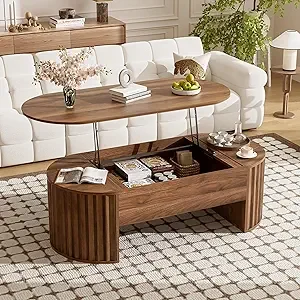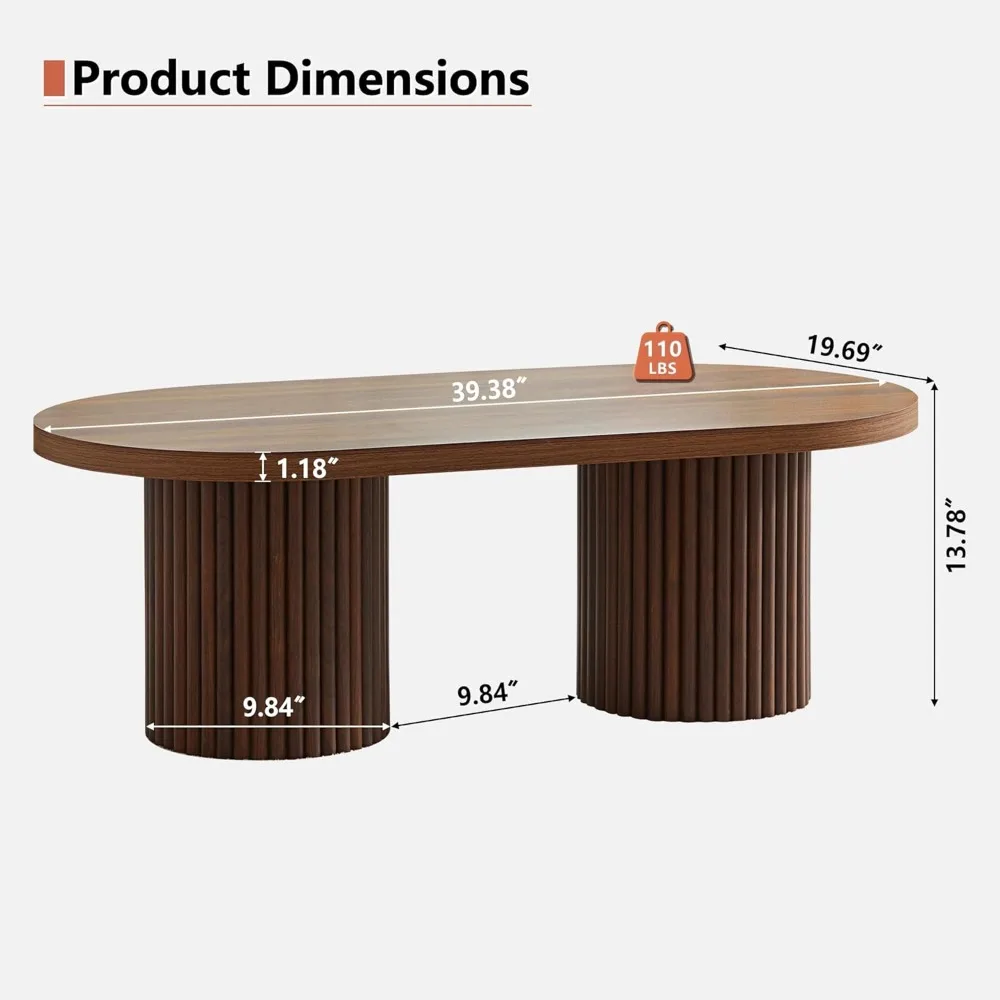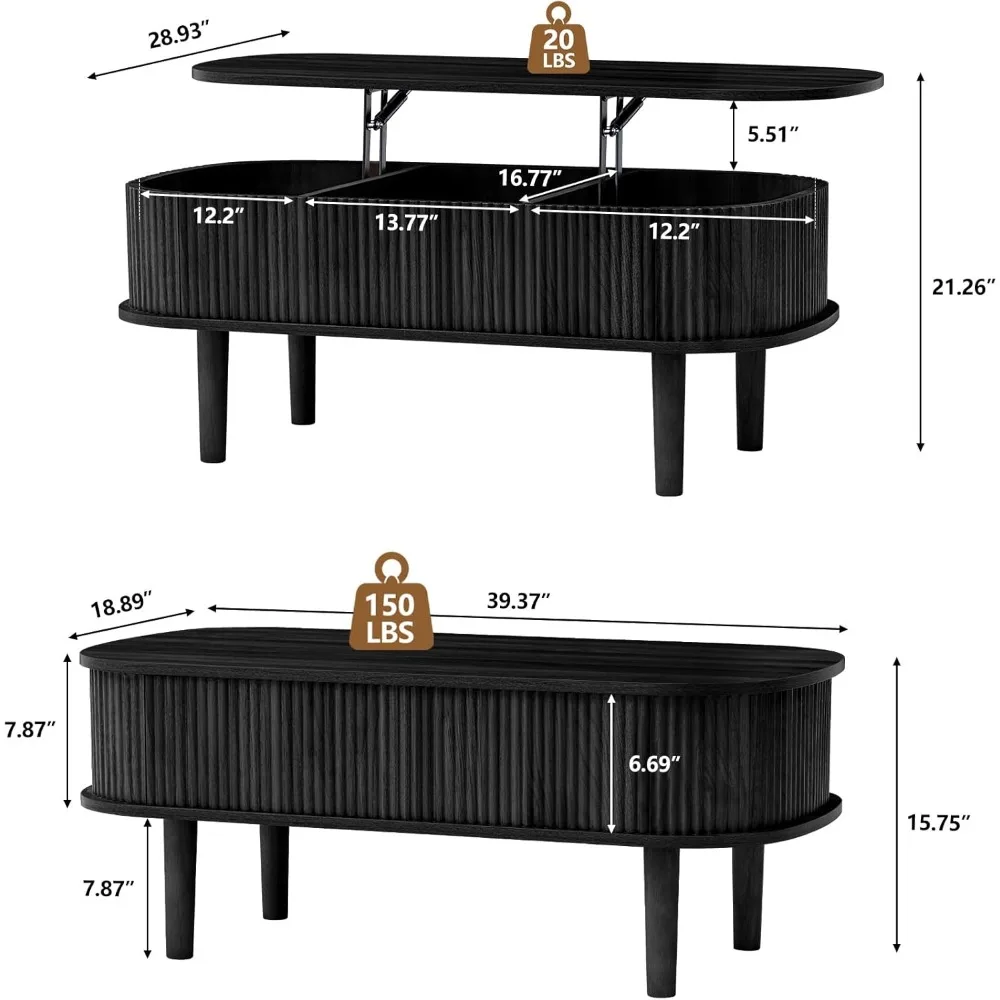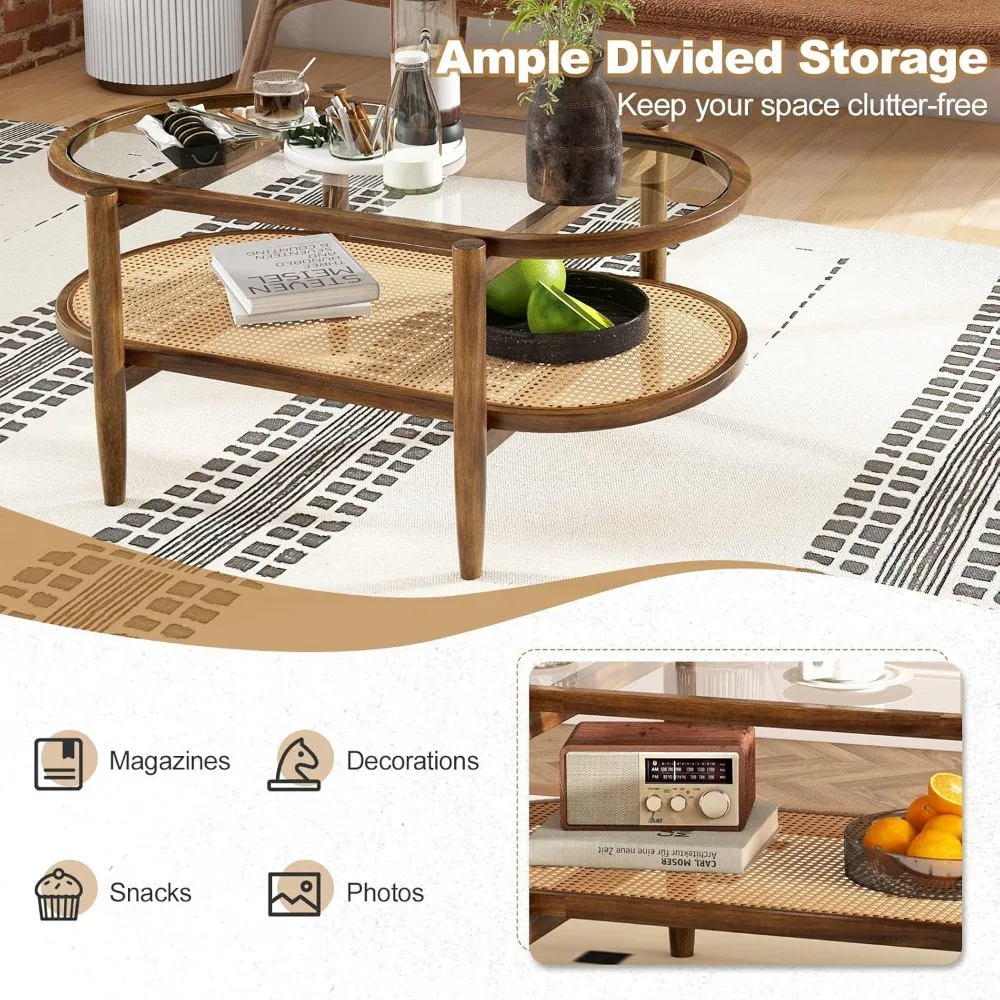The Timeless Appeal of Mid-Century Modern Oval Coffee Tables
The mid-century oval coffee table stands as a cornerstone of thoughtful living room design. More than just a place to rest your coffee cup, these elegant pieces serve as the centerpiece around which conversations flow and memories form. Their enduring popularity isn’t simply a matter of trends cycling back—it’s a testament to the fundamental strength of mid-century modern design principles that emphasize clean lines, organic shapes, and perfect functionality.
Oval coffee tables offer distinct advantages over their rectangular or square counterparts. The softer edges create better traffic flow in your living space, eliminating those painful hip encounters with sharp corners. This flowing shape often makes rooms feel more spacious while offering just as much surface area for your carefully curated display.
In this guide, we’ll explore how to transform your mid-century oval coffee table into a stunning design statement that remains practical for everyday use. From mastering proportions to selecting the perfect decorative elements, you’ll discover how to create a display that honors authentic mid-century aesthetic while expressing your personal style.
The influence of iconic designers like Isamu Noguchi and Charles Eames continues to inform how we approach these versatile pieces, blending form and function in perfect harmony. Recent oval coffee table trends continue to build on these timeless foundations while introducing contemporary elements. Let’s explore how to make the most of your mid-century modern oval coffee tables.
Understanding Your Mid-Century Oval Coffee Table’s Design Elements
Before styling your coffee table, take a moment to appreciate its defining characteristics. Authentic mid-century oval tables feature distinct elements that influence your styling approach:
- Materials: Typically crafted from warm woods like teak, walnut, or oak, with occasional glass, marble, or laminate tops
- Proportions: Lower profile than contemporary tables, usually 16-18 inches high
- Legs: Tapered, angled legs often splaying outward in the signature “atomic” style
- Silhouette: Emphasis on organic shapes with gentle curves rather than harsh angles
The oval shape creates unique styling opportunities compared to rectangular or round tables. You’ll notice a natural flow around the perimeter that guides the eye in a continuous, pleasing motion. This shape allows for both linear and asymmetrical arrangements while maintaining visual harmony.
Different materials also impact your styling approach. Solid wood tables with rich grain patterns might benefit from simpler decorative elements that don’t compete with the natural beauty of the wood. Glass-topped tables can handle more visually weighty objects since the transparent surface keeps the arrangement feeling light.
The specific design features of oval-shaped tables encourage movement and connection in your space. When selecting your perfect table, explore the distinctive character of different woods like those found in mid-century modern solid wood coffee tables, each offering unique styling possibilities.
Essential Principles for Balanced Coffee Table Styling
Creating a beautifully styled oval coffee table relies on a few key principles that ensure visual harmony while maintaining functionality:
Apply the Rule of Thirds: Divide your oval table into imaginary thirds both lengthwise and widthwise. Position key decorative elements at these intersection points rather than directly in the center. This creates more dynamic visual interest than perfectly centered arrangements.
Create Height Variation: Incorporate objects of different heights to create a pleasing silhouette. Include something tall (like a slender vase), something medium (like a stack of books), and something low (like a small dish). This varied topography draws the eye across your arrangement.
Embrace Odd Numbers: Groups of three or five items generally look more natural and visually appealing than even-numbered groupings. This principle, borrowed from photography and art composition, creates a more organic feel that complements mid-century aesthetics.
Preserve Negative Space: Resist the urge to fill every inch of your table surface. The empty space between objects is just as important as the objects themselves. Negative space creates breathing room and highlights your chosen pieces.
Balance Form with Function: Reserve some accessible space for practical items like remote controls or coffee mugs. The most successful styling allows the table to remain useful while looking beautiful.
These principles form the foundation of effective coffee table styling, regardless of specific decor choices. When applied thoughtfully to oval coffee tables in mid-century design, they create arrangements that feel both intentional and effortless.
Creating Authentic Mid-Century Modern Styling Vignettes
To achieve a truly authentic mid-century modern coffee table display, focus on creating cohesive vignettes that capture the essence of the era:
- Select period-appropriate decorative elements that reflect mid-century aesthetics: look for clean lines, organic shapes, and functional beauty in each piece
- Embrace a characteristic color palette featuring earthy neutrals (walnut brown, olive green, mustard yellow) punctuated by strategic pops of brighter hues like turquoise or coral
- Incorporate signature materials including brass, teak, ceramic, and handblown glass that reflect the craftsmanship valued during this period
- Strike the perfect balance between minimalism and visual interest—avoid clutter while ensuring your display has enough texture and dimension to engage the eye
When creating your arrangement, consider how each element relates to mid-century design principles. Geometric patterns with organic influences work beautifully, as do items with both visual appeal and practical purpose. The mid-century ethos rejected purely decorative objects in favor of those that were both beautiful and useful.
For tables with transparent surfaces, explore specific glass-top mid-century coffee table layout tips to make the most of this distinctive material. Remember that authentic mid-century styling isn’t about collecting vintage pieces exclusively—it’s about capturing the spirit of innovative, thoughtful design that defined the era.

The Perfect Decor Trio: Books, Objects, and Natural Elements
The most visually appealing coffee table arrangements often follow a simple formula: books, decorative objects, and something from the natural world. Here’s how to implement this winning combination:
Selecting and Arranging Books
- Choose titles that reflect mid-century interests: architecture, design, abstract art, or vintage photography
- Stack books horizontally with the largest at the bottom, creating platforms of varying heights
- Consider book jacket colors that complement your overall color scheme
- Limit stacks to 3-5 books to maintain visual lightness
Incorporating Signature Mid-Century Objects
- Select sculptural pieces with clean lines and organic forms
- Look for decorative objects in characteristic materials: brass figurines, wooden sculptures, or ceramic vessels
- Choose pieces with historical connections to the era: starburst shapes, atomic motifs, or biomorphic forms
- Limit yourself to 2-3 special objects to prevent visual clutter
Bringing Nature to Your Table
- Add life with plants that complement mid-century aesthetics: succulents, small snake plants, or air plants
- Consider low, architectural floral arrangements featuring tropical leaves or structural blooms like protea
- Use natural wood elements like driftwood or small wooden bowls
- Incorporate organic shapes that echo the flowing lines of your oval table
This trio approach works because it provides variety in texture, height, and visual weight while maintaining a cohesive look. Learning to perfectly style oval coffee tables often comes down to this balance of elements. For the most authentic look, pair these styling elements with carefully crafted pieces like mid-century modern walnut coffee tables, whose warm tones enhance most decor choices.
Strategic Use of Decorative Trays and Containers
Decorative trays are the secret weapon in coffee table styling, especially for oval surfaces. They serve multiple purposes:
- Define zones on your table surface, creating visual organization
- Corral small items that might otherwise look cluttered
- Add another layer of texture and material to your arrangement
- Make it easier to move multiple items when you need to clear the table
When selecting trays for mid-century styling, look for materials that enhance the period aesthetic: walnut or teak wood, brass or copper, or ceramic with simple geometric patterns. The shape of your tray should complement your oval table—consider softly rectangular trays with rounded corners or smaller oval trays that echo the table’s shape.
Balance is crucial when choosing tray size. On a standard oval coffee table, your tray should occupy roughly one-third to one-half of the available surface. This provides enough room for your display while preserving some open table space.
For practical storage, incorporate decorative boxes in complementary materials. These can discreetly house remote controls, coasters, or other small items that need to remain accessible. Look for simple, clean-lined boxes with minimal ornamentation to maintain the mid-century modern aesthetic.

For additional storage solutions, consider mid-century modern lift-top coffee tables that offer hidden compartments while maintaining clean lines.
Playing with Scale and Proportion on Your Oval Surface
Mastering scale and proportion transforms an ordinary coffee table display into something extraordinary. This skill becomes particularly important when working with oval tables, which naturally guide the eye in a circular flow.
Understanding visual weight helps create balanced arrangements. Larger, heavier-looking objects anchor your display, while smaller, more delicate pieces add detail and interest. A common mistake is using too many small items, which can create a cluttered feel. Instead, include at least one statement piece with presence—perhaps a substantial sculptural object or a larger low bowl.
Create focal points by positioning your most interesting piece slightly off-center. This draws the eye naturally and creates more dynamic tension than centered arrangements. For oval tables, positioning focal points along the long axis often works well.
Layer items effectively by placing some objects in front of or beside others rather than spacing everything evenly apart. This creates depth and makes your arrangement feel more natural. Consider the relationship between neighboring items—varying textures and shapes creates visual conversation between pieces.
Adjust your approach based on your table’s specific dimensions. Longer oval tables can handle more distinct groupings, while smaller tables might look best with a single, well-edited vignette. The specific differences between oval vs. rectangular coffee tables influence how you’ll approach these proportional relationships.
Seasonal Refreshes for Your Mid-Century Coffee Table
Keeping your coffee table styling fresh throughout the year doesn’t mean abandoning mid-century principles. Instead, make subtle seasonal adjustments that honor the design aesthetic while reflecting the changing seasons:
Spring Styling
- Introduce clear glass vessels with simple floral arrangements featuring tulips or daffodils
- Lighten your color palette with pastel accents that complement wood tones
- Swap heavy objects for lighter, more delicate pieces
- Add botanical-themed coffee table books reflecting the season’s growth
Summer Arrangements
- Incorporate natural textures like rattan, light woods, or woven elements
- Display collections of found objects from summer travels (shells, smooth stones)
- Choose vibrant accent colors like turquoise or coral that pop against wood surfaces
- Select books featuring landscapes, coastal imagery, or outdoor design
Fall Displays
- Warm the palette with amber glass, copper accents, or objects in terracotta tones
- Introduce more substantial wooden elements with rich grain patterns
- Display seasonal botanicals like small branches with changing leaves or dried seed pods
- Select art books with warmer color schemes and earthier subjects
Winter Styling
- Add strategic lighting with simple, sculptural candle holders or small accent lamps
- Incorporate more substantial objects with greater visual weight
- Choose accessories in deeper jewel tones that create a sense of warmth
- Display books about architecture or interior design for indoor inspiration
These seasonal adjustments keep your space feeling fresh while maintaining the integrity of your mid-century design scheme. For a consistently authentic look, consider anchoring your seasonal styling with mid-century modern teak coffee tables, whose warm honey tones adapt beautifully to changing seasonal palettes.
Harmonizing Your Coffee Table with the Wider Room Design
Your coffee table doesn’t exist in isolation—it’s part of your room’s larger design narrative. Creating visual harmony between your styled table and the surrounding space elevates your entire living room:
- Create material connections by echoing elements from elsewhere in the room. If your dining chairs feature walnut, incorporate walnut elements in your coffee table styling.
- Establish color threads that tie your table display to nearby textiles or artwork. Pull subtle accent colors from your rug or throw pillows into your table accessories.
- Consider sightlines from different seating positions. Your arrangement should look intentional from any angle, not just when viewed head-on.
- Balance your focal points so your coffee table styling complements rather than competes with other statement pieces like artwork or lighting fixtures.
Remember that oval coffee tables enhance room flow by creating natural pathways through your space. Their softer shape facilitates movement and conversation. When deciding between table shapes, consider how round oval mid-century coffee tables affect the overall feel of your space.
The most successful interiors feel cohesive because design elements relate to each other in meaningful ways. Your coffee table styling should feel like a natural extension of your overall design scheme rather than an isolated vignette.

Mid-Century Modern Solid Wood Coffee Tables, Mid-Century Modern Teak Coffee Tables
$879.95 Select options This product has multiple variants. The options may be chosen on the product pageMid-Century Modern Danish Coffee Tables, Mid-Century Modern Oval Coffee Tables, Mid-Century Modern Solid Wood Coffee Tables
$390.05 Select options This product has multiple variants. The options may be chosen on the product pageMid-Century Modern Coffee & End Table Sets, Mid-Century Modern Coffee Table Sets, Mid-Century Modern Oval Coffee Tables
Price range: $257.48 through $331.04 Select options This product has multiple variants. The options may be chosen on the product pageMid-Century Modern Glass Top Coffee Tables, Mid-Century Modern Glass Top Side & End Tables
$460.58 Select options This product has multiple variants. The options may be chosen on the product pageMid-Century Modern Glass Top Coffee Tables, Mid-Century Modern Vintage Coffee Tables, Mid-Century Modern Vintage Side & End Tables
$725.36 Select options This product has multiple variants. The options may be chosen on the product pageMid-Century Modern Lift Top Coffee Tables, Mid-Century Modern Square Coffee Tables
$454.73 Select options This product has multiple variants. The options may be chosen on the product page
Practical Solutions for Everyday Living with Your Styled Table
A beautifully styled coffee table must also function in daily life. These practical solutions help maintain your aesthetic while accommodating real-world needs:
Problem: Remote Controls and Electronics Clutter
* Solution: Select a decorative box with clean lines and mid-century appropriate materials to corral small electronics
* Solution: Consider a small drawer organizer inside a decorative box to keep remotes neatly arranged
Problem: Protecting Wood Surfaces from Drink Rings
* Solution: Choose stylish coasters that complement your mid-century aesthetic—cork, terrazzo, or simple wood options work well
* Solution: Arrange coasters in a small stack or in a sleek holder that adds to your styling rather than detracting from it
Problem: Quick Resets After Use
* Solution: Take a photo of your ideal arrangement for easy reference
* Solution: Establish a simple “home position” for key elements that can be quickly restored after the table has been used
Problem: Kid and Pet-Friendly Styling
* Solution: Avoid fragile or easily tipped items in favor of more substantial pieces
* Solution: Select closed containers for small items that might otherwise become choking hazards
* Solution: Consider weight and stability when selecting decorative objects
For tables with delicate surfaces, specific care considerations may apply. This is especially important for mid-century modern glass-top coffee tables, which require special attention to prevent scratches or damage.
Is Less More? Finding Your Personal Balance in Mid-Century Styling
Q: How minimal should my mid-century coffee table styling be?
A: While mid-century design often embraces minimalism, there’s no single “correct” level of simplicity. The key is intentionality—each item should serve either a practical purpose or contribute meaningfully to the aesthetic. Your personal comfort with negative space will help determine the right balance.
Q: Can I incorporate personal items that aren’t strictly mid-century?
A: Absolutely. The most livable spaces include personal touches that tell your story. The trick is integrating these personal elements thoughtfully. Consider how the shape, material, or color of personal items might relate to mid-century principles even if the items themselves aren’t from that era.
Q: How do I know if my coffee table is over-styled?
A: Signs of over-styling include difficulty using the table for its intended purpose, visual confusion where no clear focal points emerge, or feeling stressed about maintaining a complex arrangement. If your styling feels precious rather than livable, it’s probably time to edit.
Q: When is it appropriate to break conventional styling “rules”?
A: Design rules provide useful guidance but shouldn’t restrict personal expression. Break rules intentionally rather than accidentally—understand the principle you’re setting aside and have a clear reason for doing so. Often the most memorable spaces include thoughtful departures from convention.
The beauty of mid-century design philosophy is its emphasis on honest expression of materials and purpose. Let this guide your personal interpretation rather than feeling constrained by rigid rules.
Where to Source Authentic Mid-Century Decorative Accessories
Finding the perfect decorative elements for your coffee table styling often requires exploring various sources. Here are the best places to discover authentic mid-century accessories:
Vintage and Antique Sources:
* Estate sales and auctions in established neighborhoods
* Specialized mid-century vintage shops and dealers
* Online vintage marketplaces that verify authenticity
* Antique malls with dedicated mid-century sections
Contemporary Retailers for Mid-Century Inspired Pieces:
* Design-focused home goods stores specializing in modern classics
* Museum shop collections inspired by mid-century artists and designers
* Small-batch artisans creating work with mid-century influences
* Specialty retailers focused on specific materials like ceramics or brass
Identifying Quality Pieces:
* Look for solid construction and substantial weight
* Check for maker’s marks on ceramics or metal pieces
* Examine joinery and finish quality on wooden items
* Research characteristic styles and materials before shopping
For the tables themselves, explore specialized retailers like Hearth Forms who understand the nuances of mid-century design. Understanding where to buy oval mid-century coffee tables can help ensure you start with an authentic foundation for your styling efforts.
Can You Mix Eras? Incorporating Other Design Elements with Mid-Century
Q: Can I mix mid-century pieces with contemporary accessories?
A: Yes, mid-century modern design pairs beautifully with contemporary elements. The key is finding common ground—perhaps through shared material qualities, similar color palettes, or complementary shapes. Clean-lined contemporary pieces often dialogue nicely with mid-century foundations.
Q: Which other design periods naturally complement mid-century style?
A: Scandinavian design shares many principles with mid-century modern, making it a natural companion. Elements of Japanese minimalism, Art Deco geometry, and even select industrial pieces can also blend harmoniously with mid-century pieces when thoughtfully combined.
Q: How can I maintain cohesion when mixing styles?
A: Create visual threads that connect different pieces—repeated materials, complementary colors, or echoed shapes. For coffee table styling specifically, using a consistent approach to arrangement (like the rule of thirds) helps diverse elements feel purposefully combined rather than randomly collected.
Q: What combinations should I avoid?
A: Heavily ornate or highly traditional elements often clash with mid-century modern pieces. Elaborate Victorian, baroque, or rococo objects typically create visual discord with the clean simplicity of mid-century design. When in doubt, favor pieces with simpler forms and honest materials.
The most interesting interiors often juxtapose different periods in thoughtful ways. Rather than creating a time capsule, aim for a curated mix that feels both timeless and personal while respecting the core principles that make mid-century design so enduringly appealing.







